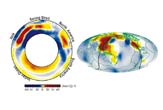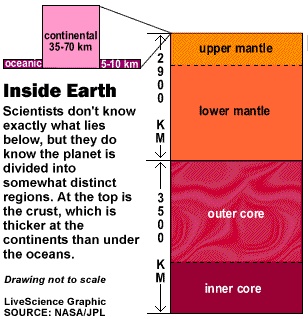
Scientists scanning the deep interior of Earth have found evidence of a vast water reservoir beneath eastern Asia that is at least the volume of the Arctic Ocean.
The discovery marks the first time such a large body of water has found in the planet's deep mantle. [The World's Biggest Oceans and Seas]
The finding, made by Michael Wysession, a seismologist at Washington University in St. Louis, and his former graduate student Jesse Lawrence, now at the University of California, San Diego, will be detailed in a forthcoming monograph to be published by the American Geophysical Union.
Looking down deep
The pair analyzed more than 600,000 seismograms — records of waves generated by earthquakes traveling through the Earth—collected from instruments scattered around the planet. [Image Gallery: This Millennium's Destructive Earthquakes]
They noticed a region beneath Asia where seismic waves appeared to dampen, or "attenuate," and also slow down slightly. "Water slows the speed of waves a little," Wysession explained. "Lots of damping and a little slowing match the predictions for water very well."
Previous predictions calculated that if a cold slab of the ocean floor were to sink thousands of miles into the Earth's mantle, the hot temperatures would cause water stored inside the rock to evaporate out.
Get the world’s most fascinating discoveries delivered straight to your inbox.
"That is exactly what we show here," Wysession said. "Water inside the rock goes down with the sinking slab and it's quite cold, but it heats up the deeper it goes, and the rock eventually becomes unstable and loses its water."
The water then rises up into the overlying region, which becomes saturated with water [image]. "It would still look like solid rock to you,” Wysession told LiveScience. "You would have to put it in the lab to find the water in it."
Although they appear solid, the composition of some ocean floor rocks is up to 15 percent water. "The water molecules are actually stuck in the mineral structure of the rock," Wysession explained. "As you heat this up, it eventually dehydrates. It's like taking clay and firing it to get all the water out."
The researchers estimate that up to 0.1 percent of the rock sinking down into the Earth's mantle in that part of the world is water, which works out to about an Arctic Ocean's worth of water.
"That's a real back of the envelope type calculation," Wysession said. "That's the best that we can do at this point."
The Beijing anomaly
Wysession has dubbed the new underground feature the "Beijing anomaly," because seismic wave attenuation was found to be highest beneath the Chinese capital city. Wysession first used the moniker during a presentation of his work at the University of Beijing.
"They thought it was very, very interesting," Wysession said. "China is under greater seismic risk than just about any country in the world, so they are very interested in seismology." [Natural Disasters: Top 10 US Threats]
Water covers 70 percent of Earth's surface and one of its many functions is to act like a lubricant for the movement of continental plates.
"Look at our sister planet, Venus," Wysession said. "It is very hot and dry inside Venus, and Venus has no plate tectonics. All the water probably boiled off, and without water, there are no plates. The system is locked up, like a rusty Tin Man with no oil."
What's Down There

The crust thickness averages about 18 miles (30 kilometers) under the continents, but is only about 3 miles (5 kilometers) under the oceans. It is light and brittle and can break. In fact it's fractured into more than a dozen major plates and several minor ones. It is where most earthquakes originate.
The mantle is more flexible – it flows instead of fractures. It extends down to about 1,800 miles (2,900 kilometers) below the surface.
The core consists of a solid inner core and a fluid outer core. The fluid contains iron, which, as it moves, generates the Earth’s magnetic field. The crust and upper mantle form the lithosphere, which is broken up into several plates that float on top of the hot molten mantle below.
SOURCE: LiveScience reporting
